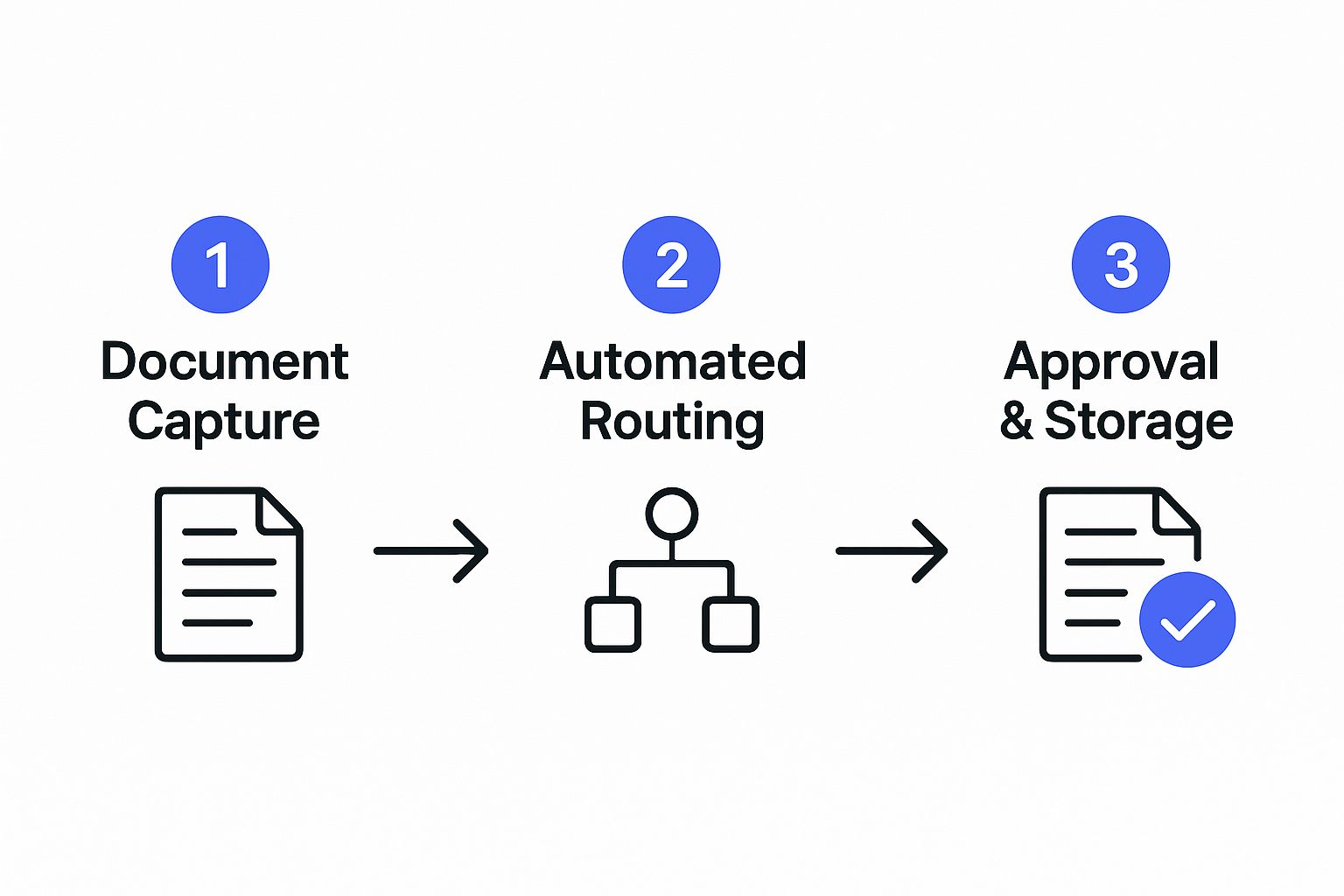
Let’s cut to the chase: "automating a document workflow" is just a fancy way of saying you're using software to handle the tedious tasks that humans usually get stuck with. Think data entry, routing documents for approval, or filing them away.
It's about swapping out those clunky, paper-and-email-based systems for a smarter, rules-driven approach. This isn't just a minor upgrade; it's a fundamental shift that helps businesses cut costs, slash errors, and get things done much, much faster.
Why Manual Document Workflows Are Holding You Back
If you're still shuffling paper or chasing approvals through endless email chains, you're not just dealing with an annoyance—you're dealing with a hidden drain on your business.
Picture this: your sales team just landed a huge client, but the contract is stuck waiting for a manager to manually review and sign it. Days tick by. Meanwhile, a quicker competitor swoops in and snatches the deal. Or imagine your finance team, drowning in a sea of invoices at the end of the month, painstakingly keying data into a spreadsheet. One little typo, and you've just overpaid a vendor.
These aren't just hypotheticals. They're the daily reality for countless companies stuck in the past. Every moment an employee spends searching for a lost file, hounding a colleague for a signature, or re-typing data is a moment they aren't spending on work that actually grows the business. These bottlenecks don't just slow one person down; they create a ripple effect of inefficiency across the entire organization.
The True Cost of Inefficiency
Relying on manual workflows isn't just slow; it's risky. Simple human error, like misfiling a critical compliance document, can lead to some seriously costly fines and legal headaches.
When it comes to legal documents, for example, you need absolute precision and a clear audit trail for everything. We actually have a whole guide on effective legal document management that dives deeper into how structured systems can save you from these kinds of nightmares.
The market is already making its choice. The global document automation software market was valued at USD 3.4 billion in 2023 and is projected to rocket to USD 10.8 billion by 2033. The message is clear: companies that fail to automate are going to be left in the dust by their more agile competitors.
The real problem with manual workflows isn't just that they're slow—it's that they're unpredictable. Automation brings consistency, making sure every single document follows the exact same process, every single time.
From Manual Pains to Automated Gains
To really get a feel for the difference, it helps to see it side-by-side. The table below gives you a quick look at how automation transforms common document tasks, turning frustrating bottlenecks into smooth, hands-off processes.
This is where the magic really happens—turning tedious chores into background tasks you don't even have to think about.
From Manual Pains to Automated Gains
A quick look at how automation transforms common document tasks, turning bottlenecks into efficient processes.
| Workflow Stage | Manual Task Example | Automated Action Example |
|---|---|---|
| Creation | Copy-pasting client info into a contract template. | Generating a new contract populated with data from your CRM. |
| Review | Emailing a document to multiple people for feedback. | Routing the document to stakeholders in a specific order. |
| Approval | Physically walking a document to a manager's desk for a signature. | Sending an automated request for a digital signature via email or Slack. |
| Archiving | Printing and filing the signed document in a physical cabinet. | Automatically saving the signed document to a secure cloud folder. |
By automating these stages, you're not just saving time. You're building a more reliable, predictable, and scalable system for your entire business.
How to Map Your Current Document Processes

Jumping straight into automation software without a clear map is like starting a road trip with no destination. Before you can effectively automate document workflow processes, you need a painfully honest look at what you’re doing right now—warts and all.
This initial mapping phase isn't just a nice-to-have; it's non-negotiable. It’s where you uncover all the hidden roadblocks and start building a real business case for change. After all, you can’t fix what you can’t see.
Trace the Document Journey
Start by picking one specific document and tracing its entire lifecycle from creation to filing. Let's use a new vendor contract as our guinea pig. Grab a whiteboard or fire up a simple flowchart tool and physically draw out every single step it takes.
You’ll want to ask some tough questions at each stage:
- Creation: Who drafts the contract? Where do they pull the information from, and what do they need to get started?
- Review: Where does it go next? Does it hit the legal department first, then finance? Or do they both review it at the same time? Get specific about the people involved in that review loop.
- Approval: Who has the final say? What happens if they reject it or demand changes?
- Execution: How does the contract get signed? Are we still printing, signing with ink, and scanning? Or is it sent out through an e-signature platform?
- Storage: Once it’s all signed, where does the final version live? Who’s in charge of making sure it’s filed correctly?
This hands-on approach forces you to confront the messy reality of your current system. Don't be shocked if the "simple" process you thought you had is actually a tangled web of back-and-forth emails and frustrating delays.
This visualization exercise is often the most eye-opening part of the entire project. It’s where teams realize a five-step process is actually a 15-step process clogged with manual data entry and email follow-ups.
Identify the Automation Opportunities
Once you have your process map laid out, the bottlenecks will practically jump off the page. This is where you put on your problem-solver hat and start pinpointing every single manual touchpoint that’s begging to be automated.
Look for recurring patterns of inefficiency. For example, is your team constantly re-typing the same client information from your CRM into a Word doc? That’s a prime candidate for automated document generation. Are contracts getting stuck for days because an approval email got buried in someone’s inbox? That’s a clear signal you need automated routing and notifications.
Group these pain points to figure out where you’ll get the biggest bang for your buck.
Common Bottlenecks to Target:
- Manual Data Entry: Copying and pasting information between systems (e.g., from an email to a spreadsheet to a contract).
- Email-Based Approvals: Using chaotic email threads to manage reviews, which leads to version control nightmares and lost documents.
- Physical Signatures: The whole print-sign-scan routine that wastes time and paper.
- Disorganized Storage: Final documents getting lost in personal folders, messy shared drives, or email attachments with zero consistent naming conventions.
Every single issue you identify is another reason to automate your document workflow. By putting a number on the time wasted on these repetitive tasks, you’re not just mapping a process—you’re building an undeniable argument for a better way of working. This map becomes your blueprint for a much more efficient future.
Choosing the Right Document Automation Tools

Alright, you’ve mapped out your current document headaches and have a clear picture of what an automated future could look like. Now for the fun part: picking the right software to make it happen.
The market for tools that automate document workflow is crowded, and it’s easy to get overwhelmed. The trick is to find a tool that fits your needs, not the other way around. Don't get distracted by a platform boasting a thousand features when you only need five of them.
Instead, zero in on what truly matters: seamless integrations with your existing tech, solid security, room to grow, and an interface your team will actually use without needing a week of training.
Start With Integrations and Core Needs
Your document automation tool can't be an island. It has to play nicely with the systems you already live in every day, like your Customer Relationship Management (CRM) or Enterprise Resource Planning (ERP) software.
Without solid integrations, you're just swapping one manual task for another—endlessly copying and pasting data between apps. Think about it: if your sales team uses Salesforce, you need a tool that can automatically grab client data from there to populate a new contract. This single connection kills manual entry and slashes the risk of embarrassing typos.
You need to see if a tool can plug into your world before you commit. If the software you rely on isn't on a potential tool's integration list, it’s probably not the right choice for your business.
Evaluate Different Tiers of Automation Solutions
Automation software isn't one-size-fits-all. A freelance consultant managing a few contracts a month has wildly different needs than an enterprise finance team processing thousands of invoices. It helps to think of solutions in tiers, each built for a specific scale and complexity.
This is where the shift to cloud-based platforms really benefits businesses of all sizes. The cloud model offers scalability and lower IT overhead, which is a huge win for modern teams. You can find more data on this trend in the full market analysis from DataIntelo.
The best tool is the one that solves your immediate problems while giving you room to grow. Start with your biggest bottleneck and choose a platform that can expand its capabilities as your automation ambitions increase.
To make this crystal clear, let's look at the different types of tools out there. The table below breaks down the common solution tiers to help you figure out where your organization fits.
Comparing Document Automation Solution Tiers
This table compares different types of automation tools, helping you choose the right fit based on your business's specific needs and budget.
| Solution Tier | Ideal For | Key Features | Example Use Case |
|---|---|---|---|
| Workflow Connectors | Small teams, startups, and individuals with simple, linear tasks. | Connects apps, basic "if-this-then-that" logic, pre-built integrations. | Automatically saving signed DocuSign contracts from Gmail to a specific Google Drive folder. |
| All-in-One Platforms | Mid-sized businesses needing end-to-end process management. | Document generation, conditional logic, approval workflows, e-signatures, analytics. | A new employee onboarding process that generates an offer letter, routes it for approval, and sends it for signature. |
| Enterprise-Grade (IDP) | Large organizations with high-volume, complex, or unstructured documents. | AI/ML data extraction, advanced security, deep ERP/CRM integration, compliance reporting. | Processing 10,000 vendor invoices per month by automatically extracting line-item data and entering it into an accounting system. |
Understanding these categories helps you cut through the noise and focus on tools that genuinely match your company's scale, budget, and technical needs. This approach ensures you invest in a solution that delivers real value from day one.
Building Your First Automated Workflow
Alright, you've mapped your process and picked your tools. Now for the fun part: putting it all into action. This is where you actually automate document workflow processes and start to see a real payoff. We'll build out a common, high-impact workflow that most businesses can relate to: new client onboarding.
Think about the old way of doing things. You'd probably create a contract manually in Word, email it around for internal review, chase down a signature, and then hopefully remember to save the final version to a shared drive. It was slow, clunky, and way too easy for things to fall through the cracks. We're going to fix that.
This simple flow chart captures the essence of what we're building—a clean, automated path from capturing information to storing the final, signed document.

The beauty of this is how it cuts out all the manual handoffs, creating a clear, repeatable journey for every single document.
Setting Up a Dynamic Template
First things first, we need a smart template. Forget static Word files. A dynamic template uses placeholders, often called "merge fields," that your automation software fills in for you. In our client onboarding example, you’d link this template directly to your CRM.
The moment a sales rep flips a deal to "Won" in the CRM, the workflow kicks off. It automatically pulls key details—the client’s name, address, services they bought—and plugs them right into your contract template. Just like that, you've eliminated manual data entry, slashed the risk of typos, and generated a ready-to-send contract in seconds.
Implementing Conditional Logic for Approvals
Of course, not all contracts are the same. Some need a second look, while others are standard enough to go right out the door. This is where conditional logic, or simple "if-then" rules, becomes your best friend. You can build rules that adapt the workflow based on the document's content.
For example, you could set up a rule that says:
- IF the total contract value is under $10,000, send it straight to the client for their signature.
- BUT IF the contract value is over $10,000, first route it to the Director of Sales for an internal thumbs-up.
This simple step ensures high-value deals get the oversight they need without creating a bottleneck for smaller, routine agreements. It’s a smarter way to manage risk without grinding the whole process to a halt. To see how these principles apply in more regulated industries, check out our guide on legal workflow automation.
A well-designed workflow doesn't just move documents faster; it makes smarter decisions along the way. By embedding your business rules directly into the process, you guarantee consistency and compliance every time.
Automating Notifications and Signatures
Once a contract is internally approved, the endless cycle of manual follow-up is over. The workflow takes over, automatically sending the document to the client using an e-signature tool like DocuSign or Adobe Sign.
At the same time, it can ping your team's Slack channel to let everyone know the contract is out for signature. And when the client signs? The system notifies all the key players and—this is the best part—automatically archives the fully executed document in the right folder, with a clean, standardized file name.
No more hunting for a file named "Final_Contract_v3_SIGNED.pdf" buried in someone's email.
Unlock Advanced Automation with IDP and AI

While standard automation is great for structured data, what about all the messy, unpredictable documents that clog up every office? I’m talking about vendor invoices, client contracts, or piles of receipts—each one with a completely different layout.
This is where you need to automate document workflow with a much smarter approach: Intelligent Document Processing (IDP).
IDP is a true game-changer. It leans on Artificial Intelligence (AI) and Machine Learning (ML) to do what basic software just can't. It doesn’t just scan a document; it actually reads and understands it, almost like a human would.
This technology can pinpoint and pull out specific information, no matter where it shows up on the page.
Moving Beyond Simple Scans
Picture your accounting team getting an invoice. A simple automation tool might just turn it into a PDF and file it away. An IDP system, on the other hand, can actually identify the vendor's name, invoice number, due date, and even break down each line item and its cost.
From there, the system intelligently sends that extracted data straight into your accounting software. Manual data entry is completely gone. That’s the real power of IDP: turning unstructured chaos into clean, actionable data that can kickstart other automated workflows. It's especially useful for complex files, and understanding legal document automation shows you just how vital this kind of precision is.
The impact is massive. IDP lets businesses process huge volumes of variable documents with incredible speed and accuracy.
IDP is the bridge between the physical and digital worlds. It translates the messy, human-centric format of paper documents into the clean, structured data that software needs to operate efficiently.
Real-World Impact and Future Growth
This isn't just some niche tech; it's quickly becoming essential for any business trying to manage information at scale. The global market for intelligent document processing is set to explode, projected to hit over USD 12.35 billion by 2030. You can find more on these numbers in Grand View Research's market analysis.
This massive growth tells you everything you need to know about how critical IDP is becoming for businesses that want to stay in the game.
By bringing in IDP, you can finally automate the most stubborn, time-sucking parts of your document processes. It frees up your team from the soul-crushing work of manual data entry, letting them focus on analysis, strategy, and other high-value tasks that actually move your business forward.
Common Questions About Document Automation
When you start thinking about how to automate document workflow, a few common questions always come up. It's completely normal. Shifting away from manual processes that you know inside and out can feel like a huge leap, but tackling these hesitations upfront makes the transition much smoother.
One of the first things people ask about is security. It's understandable to be nervous about handing over sensitive contracts, invoices, or employee records to a new piece of software. The good news is that any reputable automation tool is built with security as its foundation, often providing far better protection than a basic shared drive or email inbox.
These platforms come equipped with features designed to keep your data safe:
- Role-Based Access Control: This ensures people only see or touch the documents they’re supposed to. A sales rep can’t access HR files, and an intern can’t approve a multi-million dollar contract.
- Encryption: Your documents are scrambled and protected both in transit (as they're being sent or uploaded) and at rest (while they're stored on the server).
- Audit Trails: Every single action—from a simple view to an edit or final approval—is logged. This creates a bulletproof record for accountability and compliance.
How Do We Get the Team On Board?
The next big question is usually about getting the team to actually use the new system. How do you get people who are set in their ways to embrace a change?
The trick is to focus on the benefits, not the features.
Instead of talking about the tech, show them how it gets rid of the most annoying parts of their day. Think: no more chasing down signatures, no more digging through endless email chains to find the right version, and no more soul-crushing data entry.
Frame it in terms of "what's in it for me" for each team. For your sales team, it's about closing deals faster. For HR, it means a much cleaner onboarding process. And for finance, it’s an easier, more accurate month-end close.
The most successful rollouts I've seen always start small. Pick one process that's a huge pain point for everyone. Once your team experiences the immediate win on a workflow they already know, they'll be excited to see what else it can do.
Finally, people worry about creating another silo. Will this new tool just be one more system that doesn't talk to anything else? The best platforms are built to connect with the software you already use every day—your CRM, ERP, and cloud storage. That integration is what makes automation so powerful. It becomes a central hub for your workflows, making sure data moves between your systems smoothly and accurately without anyone having to lift a finger.
Navigating complex legal documents is a major hurdle that standard automation can't always solve. Legal Document Simplifier uses AI to instantly analyze your contracts and agreements, turning dense legal jargon into clear, actionable summaries. Upload a document to detect key terms, track deadlines, and flag risks before they become problems.
Discover how Legal Document Simplifier can protect your business.